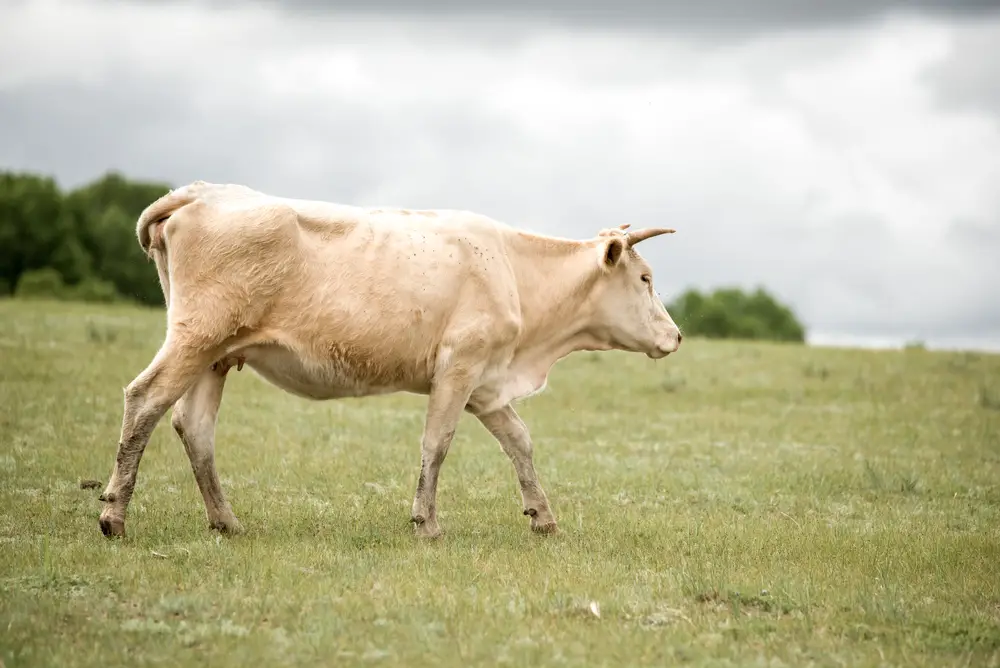The Shorthorn breed of cattle is a dual-purpose breed with excellent, award-winning beef qualities and superb milking qualities from Great Britain. Multiple specialized variations of Shorthorn cattle exist making this a cattle breed that is likely to suit any farm system.
This guide will help you decide if this breed is right for your farm.
Table of Contents
Where Does Shorthorn Cattle Come From?
Shorthorn cattle are originally from England and were descended from Teeswater cattle and Durhams in the 16th century.
It wasn’t until the 18th century that breeders Charles Colling and his brother Robert from Scotland began to selectively breed for traits including compact musculature, early maturation, and ease of weight gain.
They adopted the line breeding technique which Robert Bakewell had made famous with Longhorn cattle. This selective line breeding resulted in the creation of what we know as modern-day Shorthorn cattle.
They were first recorded in Coate’s Herd Book in 1822, which was the first pedigree book in the world for cattle.
The first importations of Shorthorn cattle to other countries including Australia and the United States occurred in the 1800s where they gained a quick foothold in both markets based on high performance, low maintenance, and dual-purpose qualities for beef and milk production.
In the 1970s, The Beef Shorthorn Cattle Society briefly allowed for the introduction of outside blood into the breed to add muscle and improve beef qualities. It was at this point that Beef Shorthorns became a separate breed from Dairy Shorthorns.
The cattle of today have diversified genetics and there are several distinct types of Shorthorn cattle with different names including:
- Beef Shorthorn
- Polled Shorthorn
- Dairy Shorthorn
- Australian Shorthorn
All of these Shorthorn variations are usually defined by their use as either beef breeds, or milkers and depend on the Shorthorn genetic traits they were selectively bred for, and the country they were developed in.
The original purebred milking Shorthorn cattle have such a small population that purebred Shorthorns are listed on the watchlist of the Rare Breeds Survivors Trust.
However, other populations of Shorthorn have gone on to assist in the development and bloodlines of over 40 other breeds worldwide and have substantial populations.
Several Breed Association Exist for Shorthorn cattle including:
The importance of Shorthorn cattle cannot be underestimated as they have an ongoing role in the cattle industry, both in their use as dual-purpose cattle, and passing on their desirable genetic traits to improve other breeds.
Shorthorn Cattle Breed Characteristics
| Official Breed Name | Shorthorn Cattle |
| Scientific Name | Bos taurus |
| Origin | Scotland |
| Appearance | White, red, or roan coloring and may have white markings Blocky conformation with wide back and deep forequarters The head is usually short and wide, and they can be polled or horned |
| Calf Weight | 85lbs |
| Mature Cow Weight | 1200lbs to 1400lbs |
| Mature Bull Weight | 1700lbs to 2200lbs |
| Ready To Breed | 12 months |
| Gestation Period | 9 months |
| First Calvings | Around 21 months |
| Time to Slaughter | 9 to 14 months |
| Carcass Weight | 736lbs |
| Expected Lifespan | 20 years |
| Productive Lifespan | 16 to 17 years |
| Known For | High-quality beef High carcass yield Crossbreeding programs Dairy quality Mothering abilities |
| Weaknesses | Tibial Hemimilia and Pulmonary Hypoplasia with Anasarca |
| Climate | Adaptable to all climates |

What Is So Special About Shorthorn Cattle?
The Shorthorn is the only modern cattle breed with a roan color. They are often used to keep solid coloring in crosses.
Shorthorns have excellent genetics and have been used in the development or improvement of over 40 breeds worldwide through crossbreeding efforts including crosses with Hereford and Holstein cattle.
Beef Production
Shorthorn cattle are known to be a profitable beef production breed, and consistently have high carcass yields and tender, quality cuts with excellent marbling. They produce consistent results when used in research projects and studies comparing meat quality.
According to The Cattle Site, “In a recent Cargill Beefworks project, 290 Shorthorn sired steers had an average yield of 60.52%, AAA grade of 53.1% and an average daily gain of 3.0 lbs./day, with a feed conversion of 6.5 lbs. dry matter/lb. gain. A premium of $9 per hundred weight was received on the AAA steers over those grading A. This amounts to nearly $7000 extra for every 100 steers making the AAA grade.”
These results were mirrored by ASA research product data, compiled by the American Shorthorn Association that out of 224 Shorthorn sires, 95% of their progeny graded USDA Choice or higher.
Why Should I Raise Shorthorn Cattle On My Farm?
- Found throughout the world, Shorthorn cattle are highly adaptable to different purposes and working environments
- Shorthorn bulls are virile breeders and can be used in commercial herds for up to 8 years which is much longer than bulls of other beef breeds
- When used in crosses, steers gain quickly and pass on high feed conversion and growth rates
- Suitable for organic farm systems
- Beef Shorthorns are well known for early finishing
- Dairy shorthorn cows can produce as much as 20,000lbs of rich milk annually with 3.8% fat and 3.4% protein and can be used in commercial operations
- Heifers mature early and reach puberty at 359 days, and are highly fertile
- Shorthorn cows have easy calving, producing high-quality calves with reasonable birth weights
- Shorthorn cows almost never need birthing assistance and are capable of calving unassisted 98% of the time
- Shorthorns are used in commercial and suckler herds worldwide
